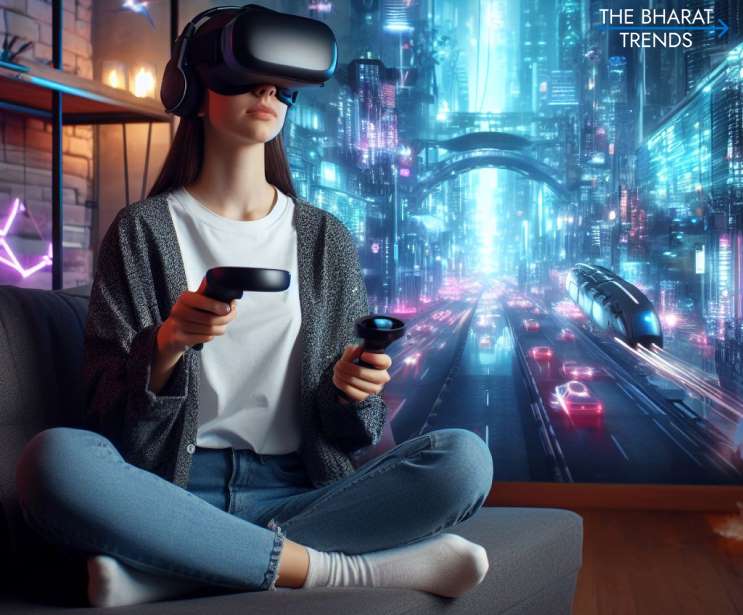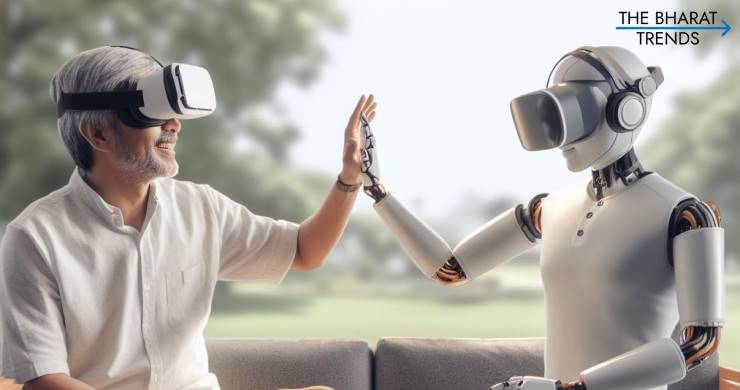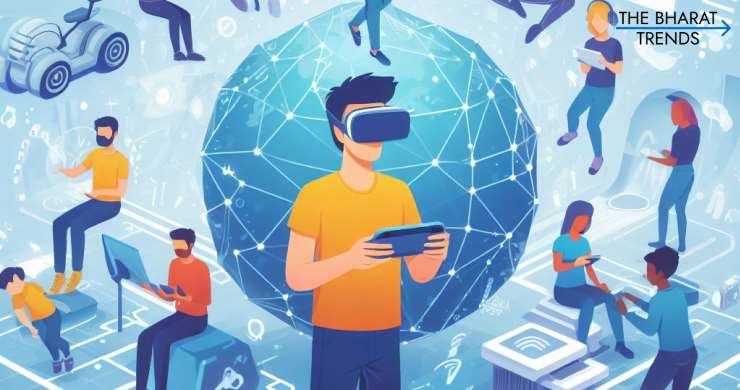In the digital age, the concept of the metaverse has transcended science fiction to become a tangible reality. A term coined in the 1992 novel “Snow Crash” by Neal Stephenson, the metaverse has evolved into a groundbreaking digital universe that beckons us with promises of boundless opportunities and challenges. In this article, we embark on a journey to explore the metaverse: What it is, why it matters, its defining features, the technologies propelling its growth, and the intriguing blend of benefits and risks it presents.
In Short:
1. Metaverse: A digital universe merging physical and virtual realms.
2. Key Technologies: VR, AR, AI, blockchain, edge computing, and high-speed networks.
3. Applications: Gaming, socializing, learning, working, shopping, healthcare, and more.
4. Challenges: Technical complexity, interoperability, privacy, security, and digital inequality.
5. Ethical & Legal Concerns: Privacy, digital identity, virtual property rights, and content moderation.
6. Impact: Transformation of work, education, culture, and human interaction.
What is the Metaverse?
At its core, the metaverse is a collective, immersive digital space that melds the physical and virtual worlds. It’s a dynamic realm where individuals interact through avatars, blurring the lines between reality and imagination. Think of it as a sprawling, interconnected network of virtual environments, from social hubs and gaming realms to workspaces and educational platforms, all accessible through the internet.

Why is the Metaverse Important?
The metaverse represents a paradigm shift in how we connect, work, and play. It’s a convergence point for technology, social interaction, and commerce. Its importance lies in its potential to redefine communication, redefine industries, and create new economic ecosystems. The metaverse is where innovation thrives, where the impossible becomes possible, and where human connection takes on a new dimension.
Also Read – Understanding the UN-India Development Partnership Fund.
Defining Feature of the Metaverse
Interconnectivity is the linchpin of the metaverse. It’s a place where diverse experiences are seamlessly woven together, allowing users to move between worlds with ease. This interconnectivity fosters an environment where individuals can navigate, collaborate, and engage across an array of digital domains. It’s the metaverse’s ability to bridge disparate realities that sets it apart.
Key Technologies Underpinning the Metaverse
Several foundational technologies fuel the metaverse’s growth. These include augmented reality (AR), virtual reality (VR), blockchain, artificial intelligence (AI), and 5G connectivity. AR and VR immerse users in digital environments, while blockchain ensures security and ownership of digital assets. AI enhances user experiences, and 5G enables high-speed, low-latency communication crucial for real-time interactions within the metaverse.
Potential Benefits and Risks of the Metaverse
The metaverse is a double-edged sword. On one hand, it offers unparalleled opportunities for innovation, education, and entertainment. It can democratize access to information and create new economic prospects. However, it also raises concerns about privacy, digital addiction, security, and ethical dilemmas. Striking a balance between its benefits and risks will be a paramount challenge as we navigate this uncharted digital frontier.
The metaverse is a transformative concept that holds the potential to reshape our world. Understanding its essence, embracing its possibilities, and mitigating its challenges will be essential as we venture further into this interconnected digital cosmos. The metaverse is more than just a buzzword; it’s a glimpse into the future of human interaction and creativity.
Building Blocks of Metaverse
The metaverse, a digital frontier set to revolutionize our lives, stands upon a foundation of advanced technologies. These core components merge reality and imagination seamlessly, offering an immersive, interconnected experience. Let’s dive into the fundamental building blocks shaping the metaverse:
- Virtual Reality (VR):
- VR immerses users in digital worlds, creating entirely new environments. It’s the basis for many metaverse experiences, providing a sensory-rich escape.
- Augmented Reality (AR):
- AR enhances reality by overlaying digital elements. It bridges the gap between the physical and digital worlds in the metaverse.
- Mixed Reality (MR):
- MR combines VR and AR, allowing digital and real elements to interact. It’s essential for dynamic metaverse experiences.
- Extended Reality (XR):
- XR covers VR, AR, and MR. It encompasses experiences blurring physical and digital worlds in the metaverse.
- Artificial Intelligence (AI):
- AI powers metaverse interactions, personalizing experiences and providing intelligent NPCs.
- Blockchain:
- Blockchain ensures metaverse asset security and ownership, enabling digital asset creation and trading.
- Edge Computing:
- Edge computing reduces latency, enabling real-time metaverse interactions by bringing processing closer to users.
- 5G and High-Speed Networks:
- High-speed networks like 5G offer bandwidth for smooth metaverse experiences, supporting real-time communication and multiplayer interactions.
These building blocks form the metaverse’s architecture, enabling a digital universe transcending physical limits. Together, they promise an era of interconnectedness, creativity, and innovation. As these technologies advance, the metaverse will evolve, blurring the line between reality and the digital world even further.
Applications of Metaverse
The metaverse, a digital realm that merges reality and imagination, offers a versatile array of applications across various domains. Here’s a crisp overview of its manifold applications:
1. Gaming and Entertainment:
- The metaverse revolutionizes gaming, providing immersive, interconnected worlds where players can interact, explore, and compete. It’s also a hub for virtual concerts, art galleries, and immersive storytelling.
2. Social Networking:
- In the metaverse, social networks transcend the 2D screen. Users interact as avatars in shared virtual spaces, fostering more meaningful connections.
3. Education and Training:
- The metaverse redefines learning, offering interactive, 3D educational environments. It enables realistic simulations and immersive training experiences.
4. Work and Collaboration:
- Businesses leverage the metaverse for remote work and collaboration. Virtual offices and meeting spaces enable teams to work together seamlessly, regardless of physical location.
5. Commerce:
- The metaverse hosts virtual marketplaces where users buy and sell digital and physical goods. Brands can create immersive shopping experiences, and digital fashion is gaining momentum.
6. Healthcare:
- Telehealth services extend into the metaverse, offering remote consultations and immersive therapy sessions. Medical simulations aid in training healthcare professionals.
7. Manufacturing and Engineering:
- Engineers and manufacturers use the metaverse for product design, prototyping, and remote maintenance. It streamlines processes and fosters innovation.
8. Government and Public Services:
- Governments utilize the metaverse for civic engagement, virtual town halls, and public services. It enhances transparency and citizen interaction.

The Future of the Metaverse
The metaverse, a vision of a fully immersive, interconnected digital universe, holds immense potential, but it also presents several significant challenges and raises ethical, legal, and societal questions.
Challenges to Making the Metaverse a Reality:
- Technical Complexity: Developing a seamless metaverse that integrates various technologies like VR, AR, AI, and high-speed networks is a massive technical challenge.
- Interoperability: Ensuring that different platforms and virtual spaces within the metaverse can communicate and interact smoothly is crucial for its success.
- Privacy and Security: Protecting user privacy and securing digital assets in a metaverse where personal data and valuable assets are at stake is a critical challenge.
- Digital Divide: Not everyone has access to the technology or internet infrastructure required for the metaverse, potentially deepening existing digital inequalities.
- Content Moderation: Maintaining a safe and respectful environment within the metaverse while respecting freedom of expression is a complex issue, especially when user-generated content is involved.
Ethical and Legal Implications of the Metaverse:
- Privacy: The metaverse collects vast amounts of personal data, raising concerns about surveillance, data breaches, and unauthorized use of user information.
- Digital Identity: Establishing and securing one’s digital identity in the metaverse becomes critical to prevent identity theft and fraud.
- Virtual Property Rights: Determining ownership and rights over virtual assets and intellectual property within the metaverse is an evolving legal challenge.
- Digital Addiction: Excessive use of the metaverse can lead to digital addiction, impacting mental health and relationships.
- Ethical AI and NPCs: The behavior of AI-controlled entities and non-playable characters (NPCs) within the metaverse raises ethical questions about their influence on user behavior.
How the Metaverse Will Change Our Lives:
- Work and Education: The metaverse will transform remote work and virtual education, making them more immersive and collaborative.
- Entertainment: Gaming and entertainment will become more interactive and engaging, with users participating as avatars in shared experiences.
- Commerce: Virtual marketplaces and digital fashion will reshape e-commerce, enabling unique shopping experiences.
- Social Interaction: Social networking in the metaverse will redefine how we connect with others, bridging geographical boundaries.
- Healthcare and Therapy: Telehealth and virtual therapy will provide more accessible and immersive healthcare services.
- Creative Expression: The metaverse will be a canvas for creative expression, from virtual art galleries to immersive storytelling.
- Governance and Public Services: Governments will use the metaverse for civic engagement and public services, enhancing transparency and citizen interaction.
Metaverse FAQ
1. What is the difference between the metaverse and virtual reality?
- Virtual reality (VR) is a technology that immerses users in a fully digital environment, while the metaverse is a broader concept—a collective, interconnected digital universe that combines VR, augmented reality (AR), and more. The metaverse includes VR experiences but goes beyond them to encompass a vast range of digital interactions and spaces.
2. What are the different types of metaverse platforms?
- Metaverse platforms vary widely. Some are game-centric (e.g., Roblox), social (e.g., Facebook’s Horizon Workrooms), or even decentralized (e.g., Decentraland). These platforms offer different experiences and features within the metaverse.
3. How do I create an avatar and enter the metaverse?
- To enter the metaverse, you typically need to sign up on a metaverse platform, create an avatar (a digital representation of yourself), and explore virtual spaces. The exact process varies depending on the platform you choose.
4. What are some of the most popular metaverse activities?
- Popular metaverse activities include gaming, attending virtual concerts, socializing with friends, participating in virtual events, exploring immersive worlds, shopping in virtual marketplaces, and even working or learning in digital environments.
5. How can businesses use the metaverse?
- Businesses can utilize the metaverse for virtual storefronts, product launches, marketing, remote work, training, and collaborative projects. It offers opportunities for innovation, customer engagement, and brand presence.
6. What are the potential safety and privacy risks of the metaverse?
- Risks include identity theft, data breaches, cyberbullying, and harassment. Users should be cautious about sharing personal information and be aware of privacy settings and moderation policies on metaverse platforms.
7. How will the metaverse impact society and culture?
- The metaverse has the potential to reshape how we interact, work, learn, and entertain ourselves. It could influence everything from digital art and fashion to education and social dynamics, creating both new opportunities and challenges in society and culture.
We have tried to maintain a straightforward language and tone to facilitate easy comprehension for both general readers and for students preparing for various exams like UPSC, SSC and so on. Please leave your feedback in the comment section below and also feel free to suggest topics you might want us to cover next.
